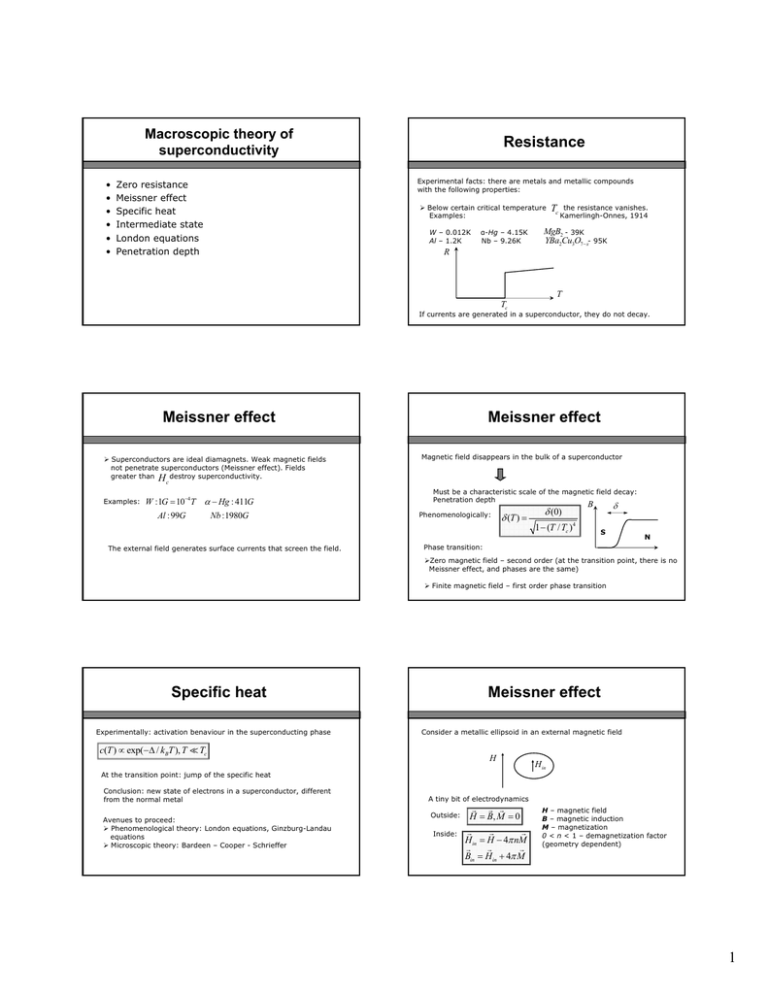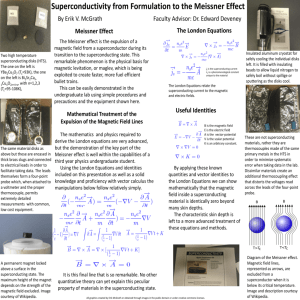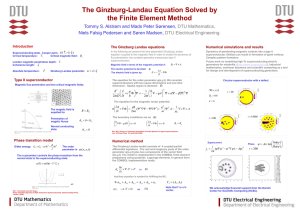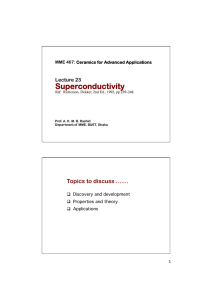1 Resistance Meissner effect Meissner effect Specific heat Meissner
advertisement

Macroscopic theory of superconductivity • • • • • • Zero resistance Meissner effect Specific heat Intermediate state London equations Penetration depth Resistance Experimental facts: there are metals and metallic compounds with the following properties: ¾ Below certain critical temperature Examples: W – 0.012K Al – 1.2K α-Hg – 4.15K Nb – 9.26K Tc the resistance vanishes. Kamerlingh-Onnes, 1914 MgB2 - 39K YBa2Cu3O7− x- 95K R T Tc If currents are generated in a superconductor, they do not decay. Meissner effect ¾ Superconductors are ideal diamagnets. Weak magnetic fields not penetrate superconductors (Meissner effect). Fields greater than H destroy superconductivity. Meissner effect Magnetic field disappears in the bulk of a superconductor c Examples: W :1G = 10−4 T α − Hg : 411G Al : 99G Nb :1980G The external field generates surface currents that screen the field. Must be a characteristic scale of the magnetic field decay: Penetration depth Phenomenologically: δ (T ) = 1 − (T / Tc ) δ B δ (0) 4 S N Phase transition: ¾Zero magnetic field – second order (at the transition point, there is no Meissner effect, and phases are the same) ¾ Finite magnetic field – first order phase transition Specific heat Experimentally: activation benaviour in the superconducting phase c(T ) ∝ exp(−∆ / kBT ), T Meissner effect Consider a metallic ellipsoid in an external magnetic field Tc H At the transition point: jump of the specific heat Conclusion: new state of electrons in a superconductor, different from the normal metal Avenues to proceed: ¾ Phenomenological theory: London equations, Ginzburg-Landau equations ¾ Microscopic theory: Bardeen – Cooper - Schrieffer Hin A tiny bit of electrodynamics Outside: H = B, M = 0 Inside: Hin = H − 4π nM H – magnetic field B – magnetic induction M – magnetization 0 < n < 1 – demagnetization factor (geometry dependent) Bin = Hin + 4π M 1 Meissner effect Intermediate state Consider now a superconducting ellipsoid in an external magnetic field Inside: H in = H − 4π nM H c (1 − n) < H < H c Coexistence of normal and superconducting states? Bin = H in + 4π M = 0 Hin = H /(1 − n) > H H > Hc N H H (1 − n) Hin = H c ⇒ B = − c n n - superconducting state H c (1 − n) < H < H c S Solution: “Intermediate state” - normal state H < H c (1 − n) N - a problem! Does not work: the field penetrates the normal parts, but then the field must decay away from S – no normal part is possible The field in the whole superconductor equals H c B Normal and superconducting domains coexist S London equations ∂ m j=E ∂t ne2 No resistance: The electrons are accelerated by the field 1 ∂H ∇× E = − c ∂t ∇× ∂ m j=E ∂t ne2 d ∂ = + v∇ dt ∂t ∂⎛ m 1 ⎞ ⎜ ∇× 2 j + H ⎟ = 0 ∂t ⎝ ne c ⎠ m 1 j+ H =0 ne2 c N H Penetration depth Phenomenological theory based on the experimental facts: Zero resistance and Meissner effect. dv d m m = eE , j = nev ⇒ j=E dt dt ne2 I related to Fermi velocity ∇× Maxwell equation: m 1 j+ H =0 ne2 c ∇× H = H S 4π j c ∆H = δ −2 H δ= mc 2 4π ne2 - penetration depth Decay of the magnetic field in the bulk of S: H exp(− x / δ ) (also the current) related to the current Estimates: δ ∼ 3 ⋅10−6 m -reasonably agrees with experiments. Should we substitute density of all electrons??? 2





